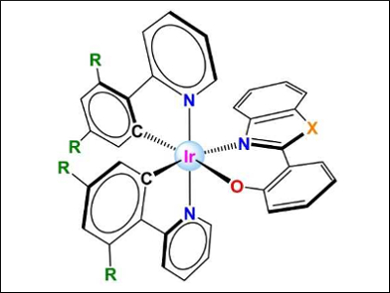Photodynamic therapy (PDT) is a chemotherapeutic protocol against cancer. It acts selectively in cancerous tissues after local activation with light. Upon light excitation, a photosensitizer (PS) initiates a photochemical reaction that produces biologically active species at cytotoxic levels.
Gustavo Espino, Begoña García, Universidad de Burgos, Spain, and colleagues have prepared neutral biscyclometalated Ir(III) complexes (pictured) as potential PS agents against colon cancer. The complexes have the general formula [Ir(C^N)2(N^O)], where the N^O ligands are 2‐(benzimidazolyl)phenolate‐N,O or 2‐(benzothiazolyl)phenolate‐N,O, and the C^N ligands are 2‐(phenyl)pyridinate derivatives. The compounds are phosphorescent, generate singlet oxygen (1O2) photocatalytically, and accumulate in cancer cells.
The team identified the complex of formula [Ir(dfppy)2(L)] (dfppy = 2‐(4,6‐difluorophenyl)pyridinate, L = 2‐(benzimidazolyl)phenolate‐N,O) as a potential agent for PDT. This complex combines excellent photophysical properties, internalization in cancer cells, and a good ability for 1O2 production. It shows an eightfold rise in cytotoxic activity upon blue-light irradiation versus in the dark. The team found that the photophysical and electrochemical properties of the described complexes depend preeminently on the N^O ligand. More studies are necessary to better understand the strong effects on the anticancer properties derived from the subtle structural change in the O^N ligand.
- Strong Influence of the Ancillary Ligand over the Photodynamic Anticancer Properties of Neutral Biscyclometalated IrIII Complexes Bearing 2-Benzoazole-Phenolates,
Marta Martínez-Alonso, Natalia Busto, Larry Danilo Aguirre, Leticia Berlanga, M. Carmen Carrión, José V. Cuevas, Ana M. Rodríguez, Arancha Carbayo, Blanca R. Manzano, Enrique Ortí, Félix A. Jalón, Begoña García, Gustavo Espino,
Chem. Eur. J. 2018.
https://doi.org/10.1002/chem.201803784




